A sensory system is a part of the nervous system responsible for processing sensory information. A sensory system consists of sensory receptors, neural pathways, and the parts of the brain involved in sensory perception. Commonly recognized sensory systems are those for vision, hearing, somatic sensation (touch), taste, and olfaction (smell).
In short, senses are transducers from the physical world to the realm of the mind where we interpret the information, creating our perception of the world around us.
The ventral spinocerebellar tract conveys proprioceptive information from the body to the cerebellum. It is part of the somatosensory system and runs in parallel with the dorsal spinocerebellar tract.
Both tracts involve two neurons. The ventral spinocerebellar tract will cross to the opposite side of the body then cross again to end in the cerebellum (referred to as a double cross). The dorsal spinocerebellar tract does not decussate, or cross sides, at all through its path.

The major tracts of the spinal cord
The anterior and posterior spinocerebellar tracts are the major somatosensory pathways communicating with the cerebellum.
The ventral tract (under L2/L3) gets its proprioceptive/fine touch/vibration information from a first order neuron, with its cell body in a dorsal ganglion. The axon runs via the fila radicularia (nerve rootlets) to the dorsal horn of the gray matter. There it makes a synapse with the dendrites of two neurons that send their axons bilaterally to the ventral border of the lateral funiculi (transmit the contralateral corticospinal and spinothalamic tracts). The ventral spinocerebellar tract then enters the cerebellum via the superior cerebellar peduncle (connects the cerebellum to the midbrain).
This is in contrast with the dorsal spinocerebellar tract (C8 - L2/L3), which only has one unilateral axon that has its cell body in Clarke's nucleus (only at the level of C8 - L2/L3). The fibers of the ventral spinocerebellar tract then eventually enter the cerebellum via the superior cerebellar peduncle.
This is one of the few afferent tracts through the superior cerebellar peduncle. Axons first cross midline in the spinal cord and run in the ventral border of the lateral funiculi. These axons ascend to the pons where they join the superior cerebellar peduncle to enter the cerebellum.
Once in the deep, white matter of the cerebellum, the axons recross the midline, give off collaterals to the globose and emboliform nuclei (deep cerebellar nuclei), and terminate in the cortex of the anterior lobe and vermis of the posterior lobe.
The dorsal spinocerebellar tract (also called the posterior spinocerebellar tract, Flechsig's fasciculus, or Flechsig's tract) conveys inconscient proprioceptive information from the body to the cerebellum. It is part of the somatosensory system and runs in parallel with the ventral spinocerebellar tract.
Proprioceptive information is taken to the spinal cord via central processes of the dorsal root ganglia (where first order neurons reside). These central processes travel through the dorsal horn where they synapse with second order neurons of Clarke's nucleus.
Axon fibers from Clarke's nucleus convey this proprioceptive information in the spinal cord to the peripheral region of the posterolateral funiculus ipsilaterally until it reaches the cerebellum, where unconscious proprioceptive information is processed. This tract involves two neurons and ends up on the same side of the body.